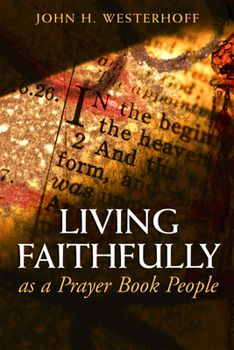Living Faithfully as a Prayer Book People
Select Format
Select Condition 
Book Overview
Episcopalians consider themselves to be people whose individual and corporate lives are shaped by the Book of Common Prayer, but aside from worship on Sunday morning, few know what fills its nearly 1,000 pages. John Westerhoff, Episcopal priest and Christian educator, walks readers through the ways in which the contents of the Prayer Book can (and should) shape the lives of those who call themselves Episcopalians. An excellent resource for parish study or reading in advance of seminary training, Westerhoff explores a brief history of the Prayer Book, and the ways in which it shapes us as pilgrims and prayerful people. How Episcopalians live into their baptism, live a Eucharistic and reconciling life, as well as a life of wholeness and health, are explored in detail. All of this, as Westerhoff writes, helps us lead a holy life, and one day, to a holy death.
Format:Paperback
Language:English
ISBN:0819219509
ISBN13:9780819219503
Release Date:December 2004
Publisher:Morehouse Publishing
Length:131 Pages
Weight:0.45 lbs.
Dimensions:0.4" x 5.5" x 8.4"
Customer Reviews
2 ratings
For People of Faith
Published by Thriftbooks.com User , 17 years ago
The Episcopal Church and the world-wide Anglican Communion have a great gift to share with all people of faith. The Book of Common Prayer is a text book in how to pray. John Westerhoff has written a basic introduction to life in a prayering community. One of Anglicanisms great spokeman on matters of Christian Spirituality is Kenneth Leech who has said, "There is no such thing as private prayer for the Christian." John Westerhoff echos this view and opens wide an invitation to share in the corporate prayer of the "The Body of Christ." LIVING FAITHFULLY AS A PRAYER BOOK PEOPLE would make a great book for Lenten study. Rod Wiltse+
By the book...
Published by Thriftbooks.com User , 19 years ago
As Westerhoff states at the beginning of this book, it is difficult to define an Episcopalian (and even more difficult to define the more general category, Anglican, of which 'Episcopalian' is a subset). 'Yet, in spite of all our differences, we have one outstanding characteristic: We are a prayer book people.' It was a running joke at my seminary (an ecumenical seminary with a very small minority of Anglican types) that one of the things that set the Episcopalian/Anglican students apart from the rest was that when you ask them to pray, they reach for a book. This is in large part due to the fact that the prayer life of the typical Anglican is informed and shaped by prayer book language. Indeed, when I've been charged to come up with 'spontaneous' prayer, I've been accused of reciting memorised prayers rather than forming new ones, because the language sounded so much like prayer book language. The use of the prayer book has a long heritage, and has shaped the Anglican identity and worship pattern for centuries. Westerhoff traces a brief history of the prayer book from the time of King Henry VIII and Archbishop Thomas Cranmer. One thing that is very apparent in this is that there is not one, perfect and sufficient Book of Common Prayer - it has been constantly revised (both in the British and American experienced, not to mention the other nations/provinces in the Anglican world), and will continue to be a 'work in progress'. However, we are in a new information age, and Westerhoff asks important questions: 'What will it mean to be a people of a book when, instead of a bound book, congregations will print user-friendly disposable leaflets for particular liturgies from an ever-changing and expanding library of resources?' Westerhoff develops the idea of the Book of Common Prayer as an integral part of the Anglican story, continuing in a strain of narrative theological analysis that is both sturdy and flexible. The Anglican idea has long been one of the via media - the aspects of narrative theological interpretation of the community and the BCP's role in it allows for continuing growth and progress while maintaining a respect for history and tradition. Westerhoff shows the church calendar as being a progressive re-enactment in time for the church to tell its biblically-based story. Westerhoff also explores the different kinds of prayer, both personal and communal (the word 'common' in the title of the Book of Common Prayer relates to the communal aspect of prayer). In this book, Westerhoff shares his thoughts through brief meditations and essays. He develops these on different themes that arise in the liturgies and other pieces of the prayer book - baptism, communion, reconciliation, health and healing, living and dying. This is not meant to be an exhaustive or scholarly analysis of the prayer book and its pieces, but rather a reflection upon how these different components shape, and in turn are shaped by, those who adopt and are a





